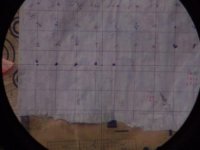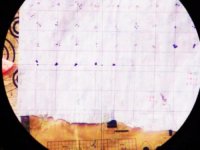I'm going to take a different tack here..... on the "harmonics" issue.
This will be utterly boring to some, to those I invite you, "don't read"
Until I had in my hands a TRULY ACCURATE RIFLE I had absolutely no clue why my results were what they were. I wore out barrels "working up loads" using every method imaginable. My rabbit trails had rabbit trails on their rabbit trails.
Then Art Cocchia built me a BR rifle. Actually, he built TWO identical rifles for myself and my friend with 7 barrels, 3 of them in "BR chamberings." With these rifles I learned some things but the STRANGEST I ever did see was that day on the marge of Lac Le Barge when I screwed a barrel on (22BR) and made a little round hole at 200yds, and then another one, and another one, and when I changed the load THE HOLE MOVED..... And it changed shape and it got bigger/smaller. And when the wind puffed the hole turned into a caterpillar, and sometimes a duck or a turtle.... but that's another story...
And then the next day when I took my friend to show heem, I DID IT AGAIN! And again.... and HE did it..... and so on....
without boring everyone with stories, my point is, "harmonics" as a useful tool only apply to ACCURATE platforms,
IMO
I can't imagine learning anything "harmonic" on a 1moa or even a half moa rifle.
An ACCURATE rifle shoots a "5-shot one hole group" ALL THE TIME, it's just the shape of the hole that changes. From harmonics. With an ACCURATE barrel you can SEE THE WIND, and you can see harmonic effects.
But I digress......
I was at a seminar where Jim Borden illustrated his and Doc Jackson's "sine wave tuning" using barrel harmonics. I've still got the videotapes....and he spoke of graphing group centers on a horizontal line, (Jim does this in a 'double-blind' setting to minimize human action) how as the charges are gradually increased the group centers went up and down as a sine wave, essentially showing the barrel wagging up and down. But as I set and watched I wondered how many people in the audience realized that all the up and down movement was INSIDE the typical group! What I'm saying is, harmonics are subtle, half-inch-out flyers AIN'T HARMONICS! Of course flyers still happen, butterflies still fly in Japan, but they're rare and hopefully accounted for by something in the field of view....
Observe the picture somewhere in this post. I took the pic during a workup section and posted it here on BRC to illustrate the view through a then-new 45 Leupold and to all you PPC/BR shooters here I must apologize because this IS NOT a short-range BR workup. I was testing a 6X47L shooting 108gr VLD's at around 3250fps......YES there's a lot of air showing but these ain't 68gr bullets, I think it still illustrates my point.
I hope anyways

Astute observers will notice some three shot and some five shot groups. Some observers may see WHY some of them are five shots...
Anyway, I didn't change my scope settings, nor was I actually graphing a sine wave here..... but you will see that the better groups are forming in a different place than the others. And furthermore, if you could read the notes on this workup you'd see that the lower groups were going faster.
Harmonics.
ONLY visible because this IS an extremely accurate rifle. (For a VLD gun) This setup will eat 30's at 600yds. And if I ever get a chance at a 300yd Group Match.... and if'n it's windy....
But again,
I digress
LOL
al
This will be utterly boring to some, to those I invite you, "don't read"
Until I had in my hands a TRULY ACCURATE RIFLE I had absolutely no clue why my results were what they were. I wore out barrels "working up loads" using every method imaginable. My rabbit trails had rabbit trails on their rabbit trails.
Then Art Cocchia built me a BR rifle. Actually, he built TWO identical rifles for myself and my friend with 7 barrels, 3 of them in "BR chamberings." With these rifles I learned some things but the STRANGEST I ever did see was that day on the marge of Lac Le Barge when I screwed a barrel on (22BR) and made a little round hole at 200yds, and then another one, and another one, and when I changed the load THE HOLE MOVED..... And it changed shape and it got bigger/smaller. And when the wind puffed the hole turned into a caterpillar, and sometimes a duck or a turtle.... but that's another story...
And then the next day when I took my friend to show heem, I DID IT AGAIN! And again.... and HE did it..... and so on....
without boring everyone with stories, my point is, "harmonics" as a useful tool only apply to ACCURATE platforms,
IMO
I can't imagine learning anything "harmonic" on a 1moa or even a half moa rifle.
An ACCURATE rifle shoots a "5-shot one hole group" ALL THE TIME, it's just the shape of the hole that changes. From harmonics. With an ACCURATE barrel you can SEE THE WIND, and you can see harmonic effects.
But I digress......
I was at a seminar where Jim Borden illustrated his and Doc Jackson's "sine wave tuning" using barrel harmonics. I've still got the videotapes....and he spoke of graphing group centers on a horizontal line, (Jim does this in a 'double-blind' setting to minimize human action) how as the charges are gradually increased the group centers went up and down as a sine wave, essentially showing the barrel wagging up and down. But as I set and watched I wondered how many people in the audience realized that all the up and down movement was INSIDE the typical group! What I'm saying is, harmonics are subtle, half-inch-out flyers AIN'T HARMONICS! Of course flyers still happen, butterflies still fly in Japan, but they're rare and hopefully accounted for by something in the field of view....
Observe the picture somewhere in this post. I took the pic during a workup section and posted it here on BRC to illustrate the view through a then-new 45 Leupold and to all you PPC/BR shooters here I must apologize because this IS NOT a short-range BR workup. I was testing a 6X47L shooting 108gr VLD's at around 3250fps......YES there's a lot of air showing but these ain't 68gr bullets, I think it still illustrates my point.
I hope anyways

Astute observers will notice some three shot and some five shot groups. Some observers may see WHY some of them are five shots...
Anyway, I didn't change my scope settings, nor was I actually graphing a sine wave here..... but you will see that the better groups are forming in a different place than the others. And furthermore, if you could read the notes on this workup you'd see that the lower groups were going faster.
Harmonics.
ONLY visible because this IS an extremely accurate rifle. (For a VLD gun) This setup will eat 30's at 600yds. And if I ever get a chance at a 300yd Group Match.... and if'n it's windy....
But again,
I digress
LOL
al


